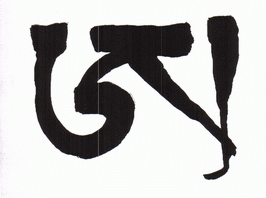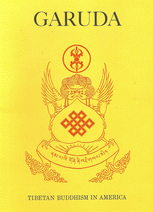

by Chogyam Trungpa Rinpoche (Mudra, 1972)
A teaching on the awakened state, by the great Dzogchen teacher Jigme Lingpa (1730-1798)
Translated by Chogyam Trungpa Rinpoche
Maha ati
THIS IS THE LION’S ROAR which subdues the rampant confusions and misunderstandings of those meditators who have abandoned materialistic attachments to meditate on the Innermost Essence.
The maha ati [Tib.: dzogchen], which is beyond conceptions and transcends both grasping and letting go, is the essence of transcendental insight. This is the unchanging state of non meditation in which there is awareness but no clinging. Understanding this, I pay ceaseless homage to the maha ati with great simplicity.
Here is the essence of the maha ati tantra,
The innermost heart of Padmakara’s teachings,
The life-force of the dakinis.
This is the ultimate teaching of all the nine vehicles.
It can be transmitted only by a guru of the thought lineage
And not by words alone.
Nevertheless I have written this
For the benefit of great meditators
Who are dedicated to the highest teaching.
This teaching was taken from the treasury of dharmadhatu
And is not created out of attachment
To theories and philosophical abstractions.
First the pupil must find an accomplished guru with whom he has a good karmic link. The teacher must be a holder of the thought lineage transmission. The pupil must have single minded devotion and faith, which makes possible the transmission of the teacher’s understanding.
The maha ati is of the greatest simplicity. It is what is. It cannot be shown by analogy; nothing can obstruct it. It is without limitation and transcends all extremes. It is clear-cut nowness, which can never change its shape or colour. When you become one with this state, the desire to meditate itself dissolves; you are freed from the chain of meditation and philosophy, and conviction is born within you. The thinker has deserted. There is no longer any benefit to be gained from “good” thoughts and no harm is to be suffered from “bad” thoughts. Neutral thoughts can no longer deceive. You become one with transcendental insight and boundless space. Then you will find signs of progress on the path. There is no longer any question of rampant confusions and misunderstandings.
Although this teaching is the king of the yanas [vehicles], meditators are divided into those who are highly receptive to it, those who are less receptive and those who are quite unreceptive. The most highly receptive pupils are hard to find, and it sometimes happens that teacher and pupil are unable to find a true meeting point. In such a case nothing is gained and misconceptions may arise concerning the nature of maha ati.
Those who are less receptive begin by studying the theory and gradually develop the feeling and true understanding. Nowadays many people regard the theory as being the meditation. Their meditation may be clear and devoid of thoughts and it may be relaxing and enjoyable, but this is merely the temporary experiencing of bliss. They think this is meditation and that no one knows any better than them. They think, “I have attained this understanding:’ and they are proud of themselves. Then, if there is no competent teacher, their experience is only theoretical. As it is said in the scriptures of maha ati: “Theory is like a patch on a coat ..one day it will come apart.”
People often try to discriminate between “good” thoughts and “bad” thoughts, like trying to separate milk from water. It is easy enough to accept the negative experiences in life but much harder to see the positive experiences as part of the path. Even those who claim to have reached the highest stage of realization are completely involved with worldly concerns and fame. They are attracted by Devaputra [personification of the force which causes attraction to sense objects]. This means they have not realized the self-liberation of the six senses. Such people regard fame as extraordinary and miraculous. This is like claiming that a raven is white. But those who are completely dedicated to the practice of dharma without being concerned about worldly fame and glory should not become too self-satisfied on account of their higher developments of meditation. They must practice the Guru Yoga throughout the four periods of the day in order to receive the blessings of the guru and to merge their minds with his and open the eye of insight.
Once this experience is attained it should not be disregarded. The yogi should thenceforth dedicate himself to this practice with unremitting perseverance. Subsequently his experience of the void will become more peaceful, or he will experience greater clarity and insight. Or again, he may begin to realize the shortcomings of discursive thoughts and thereby develop discriminating wisdom. Some individuals will be able to use both thoughts and the absence of thoughts as meditation, but it should be borne in mind that that which notes what is happening is the tight grip of ego.
Look out for the subtle hindrance of trying to analyze experiences. This is a great danger. It is too early to label all thoughts as dharmakaya [the body of ultimate truth]. The remedy is the wisdom of nowness, changeless and unfailing. Once freed from the bondage of philosophical speculation, the meditator develops penetrating awareness in his practice. If he analyzes his meditation and post-meditation experiences, he will be led astray and make many mistakes. If he fails to understand his shortcomings, he will never gain the free-flowing insight of nowness, beyond all concepts. He will have only a conceptual and nihilistic view of the void, which is characteristic of the lesser yanas.
It is also a mistake to regard the void as a mirage, as though it was merely a combination of vivid perceptions and nothingness. This is the experience of the lower mantras, which might be induced by practice of the Svabhava mantra. It is likewise a mistake, when discursive thoughts are pacified, to overlook the clarity and regard the mind as merely blank. The experience of true insight is the simultaneous awareness of both stillness and active thoughts. According to the maha ati teaching, meditation consists of seeing whatever arises in the mind and simply remaining in the state of nowness. Continuing in this state after meditation is known as “the post-meditation experience.”
It is a mistake to try to concentrate on emptiness and, after meditation, intellectually to regard everything as a mirage. Primordial insight is the state which is not influenced by the undergrowth of thoughts. It is a mistake to be on guard against the wandering mind or to try and imprison the mind in the ascetic practice of suppressing thoughts.
Some people may misunderstand the term “nowness” and take it to refer to whatever thoughts happen to be in their mind at the moment. Nowness should be understood as being the primeval insight already described.
The state of non meditation is born in the heart when one no longer discriminates between meditation and non-meditation and one is no longer tempted to change or prolong the state of meditation. There is all-pervading joy, free from all doubts. This is different from the enjoyment of sensual pleasures or from mere happiness.
When we speak of “clarity” we are referring to that state which is free from sloth and dullness. This clarity, inseparable from pure energy, shines forth unobstructed. It is a mistake to equate clarity with awareness of thoughts and the colors and shapes of external phenomena.
When thoughts are absent the meditator is completely immersed in the space of non-thought. The “absence of thoughts” does not mean unconsciousness or sleep or withdrawal from the senses, but simply being unmoved by conflict. The three signs of meditation clarity, joy and absence of thoughts may occur naturally when a person meditates, but if an effort is made to create them the meditator still remains in the circle of samsara.
There are four mistaken views of the void. It is a mistake to imagine that the void is merely empty without seeing the wild space of nowness. It is a mistake to seek the buddha nature in external sources, without realizing that nowness knows no path or goal. It is a mistake to try to introduce some remedy for thoughts without realizing that thoughts are by nature void and that one can free oneself like a snake unwinding. It is also a mistake to hold a nihilistic view that there is nothing but the void, no cause and effect of karma and no meditator nor meditation, failing to experience the void which is beyond conceptions.
Those who have had glimpses of realization must know these dangers and study them thoroughly. It is easy to theorize and talk eloquently about the void, but the meditator may still be unable to deal with certain situations. In a maha ati text it is said:
“Temporary realization is like a mist which will surely disappear’ Meditators who have not studied these dangers will never derive any benefit from being in strict retreat or forcibly restraining the mind, nor from visualizing, reciting mantras or practicing Hathayoga. As is said in the Phagpa Dudpa Sutra,
“A Bodhisattva who does not know the real meaning of solitude,
Even if he meditates for many years in a remote valley full of
poisonous snakes
Five hundred miles from the nearest habitation,
Would develop overwhelming pride.”
If the meditator is able to use whatever occurs in his life as the path, his body becomes a retreat hut. He does not need to add up the number of years he has been meditating and does not panic when “shocking” thoughts arise. His awareness remains unbroken like that of an old man watching a child at play. As is said in a maha ati text: “Complete realization is like unchanging space.”
The yogi of maha ati may look like an ordinary person but his awareness is completely absorbed in nowness. He has no need of books because he sees apparent phenomena and the whole of existence as the mandala of the guru. For him there is no speculation about the stages on the path. His actions are spontaneous and therefore benefit all sentient beings. When he leaves the physical body his consciousness becomes one with the dharmakaya, just as the air in a vase merges with the surrounding space when the vase is broken.
From Mudra, by Chogyam Trungpa
return to Beezone Articles
A wonderful project devoted to collecting stories of Chögyam Trungpa Rinpoche
See more on Chogyam Trungpa
Rinpoche from the first issue of the
Garuda
magazine

published in 1971.